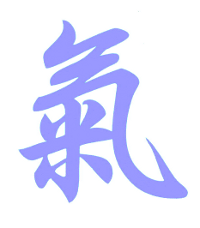


Tai Chi and Qi Gong
Tai Chi
"A Traditional Chinese Art, practiced for mental, physical, and spiritual discipline for cultivating the internal energy system."
Tai Chi comprises a series of postures linked by slow, graceful movements and accompanied by breathing techniques that focus concentration.
The sequence is designed to restore and enhance the flow of "Qi", or "vital energy", exercising mind, body and spirit to bring health and an overall sense of well-being, and the achievement of improved co-ordination, flexibility and peace of mind.

"Qi" Chinese Character
more about Tai Chi
Tai Chi is unique among the "Three Sister Arts" (Xing Yi, Bagua Zhang, and Tai-Ji) in having the greatest affinity to Wuji (the first, most ancient of the Chinese Internal Arts) in that both Tai-Chi and Wuji, in addition to their renowned fighting application, also provide very great benefits to mental, physical, and ultimately, spiritual well-being.
Tai Chi's creation is attributed to the legendary figure of the late Song Dynasty Daoist Zhang San Feng (who resided at the famous Wudang Daoist Monastery during the 12th century), but it is certain that the art was being practiced in elementary form long before his day - just as the older, partly related, lesser well known art of the Wuji has origins still more ancient.
However, the founder of the first form of Tai-Ji in a definitive form was Chen Wang Ting (1600-1680). Chen Style Tai-Ji is the oldest of the five major styles of Tai-Ji: Yang Style being the most commonly practiced and popular of the five (Chen, Yang, Wu, Sun, Wu/Hao).
Qi Gong
"The science of Therapeutic Breathing and inter-related, co-ordinated movement of body and limbs."
Qi Gong is a form of gentle exercise with slow coordinated movements, synchronized in conjunction with correct breathing, to harmonize mind, body, and spirit to either restore or maintain an equilibrium/balance within the body.
Qi Gong can also be used as a form of rehabilitation and stress release. Qi Gong is also used as a prior knowledge to Tai Chi.
Qi Gong is an integral part of TCM (Traditional Chinese Medicine) preventative and remedial treatment for a wide range of health conditions.
Medical Qi Gong is a specific and ancient discipline and its use as a standard medical technique in Chinese hospitals has been officially recognized since 1989.
more about Qi Gong
There are three core types of Qi Gong - Soft, Semi-Hard, and Hard - used for therapeutic benefit, and, or, martial application. Qi Gong is practiced to generate, retain, and direct qi: as such it is most well-known for being practiced purely for its many health benefits.
Qi Gong is a very ancient art, closely related to the martial arts, but predating them. Its earliest rudimentary forms being practiced almost certainly some 5,000 years ago, and we find that during the Shang Dynasty (18th century BCE) its existence was indicated through reference to qi on some of the oracle bones of that period, and by supportive evidence found amongst some Zhou Dynasty inscriptions.
In those ancient times the peoples of China realised through observation, accidental discovery, and experimentation (for instance articulation of the joints of the body in different ways), that certain controlled movements of the body and its hands, feet, and limbs, allied to different breathing techniques and focused concentration lead to greater stamina, clarity of mind and spirit, and medical well-being.
Qi Gong is indebted to the practice of observation of the characteristics of Nature: for instance, the Five Elements and their inter-relationship, which requires balance and harmony, and also the characteristics of other living beings, birds, animals, fish, and insects - hence Daoyin (Wild Goose) Qi Gong. One of the most famous of Qi Gong systems is that ascribed to the legendary physician, Dr Hwa Tuo (2nd century) who created his Five Animal Frolics (Qi Gong) based on observation of the characteristics and movements of the bear, deer, birds, apes, and tiger.



